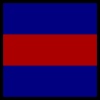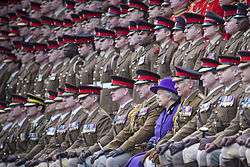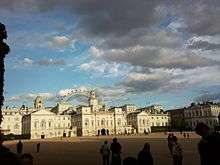Household Cavalry
The Household Cavalry (HCav) is made up of the two most senior regiments of the British Army, the Life Guards and the Blues and Royals (Royal Horse Guards and 1st Dragoons). These regiments are divided between the Armoured Regiment stationed at Kiwi Barracks in Wiltshire and the ceremonial mounted unit, the Household Cavalry Mounted Regiment, garrisoned at Hyde Park Barracks (Knightsbridge Barracks) in London. The Household Cavalry is part of the Household Division and is the Queen's official bodyguard.
| Household Cavalry | |
|---|---|
 Badge of the Household Cavalry[1] | |
| Active | Since 1992 (roots dating back to 1660) |
| Country | United Kingdom |
| Branch | |
| Type | Horse Guards |
| Role | Household Cavalry Regiment – Armoured Cavalry Regiment Household Cavalry Mounted Regiment – Public duties |
| Size | Corps of two regiments: The Life Guards The Blues and Royals |
| Part of | Household Division |
| Garrison/HQ | RHQ – London |
| Motto(s) | Honi soit qui mal y pense "Shamed be he who thinks evil of it" |
| Commanders | |
| Colonel-in-Chief | HM The Queen |
| Colonels of the regiments | The Princess Royal (Blues and Royals) The Lord Guthrie (The Life Guards) |
| Insignia | |
| Tactical Recognition Flash |  |
| Abbreviation | HCav |
Life Guards and Blues and Royals
The British Household Cavalry is classed as a corps in its own right, and consists of two regiments: the Life Guards and the Blues and Royals (Royal Horse Guards and 1st Dragoons). They are the senior regular regiments in the British Army, with traditions dating from 1660, and act as the Queen's personal bodyguard. They are guards regiments and, with the five foot guard regiments, help constitute the seven guards regiments of the Household Division.
| Regiment | Tunic colour | Plume colour | Collar colour | Quick March | Slow March | Trot |
|---|---|---|---|---|---|---|
| The Life Guards | Red | White | Blue | Millanollo and Men of Harlech | Life Guards Slow March | Keel Row |
| The Blues and Royals | Blue | Red | Red | Blues and Royals and Grand March from Aida | Blues and Royals Slow March | Keel Row |
Organisation


The Household Cavalry as a whole is split into two different units that fulfil very distinct roles. These are both joint units, consisting of personnel from both regiments. Like other Cavalry formations, the Household Cavalry is divided into regiments (battalion-sized units) and squadrons (company-sized sub-units). The whole corps is under the command of the Commander Household Cavalry (formerly Lieutenant-Colonel Commanding Household Cavalry), who also holds the Royal Household appointment of Silver Stick in Waiting. He is a Colonel, and is assisted by a retired lieutenant colonel as Regimental Adjutant.[2]
The first unit is the Household Cavalry Regiment (HCR). It has an active operational role as a Formation Reconnaissance Regiment, serving in armoured fighting vehicles, which has seen them at the forefront of the nation's conflicts. The regiment serves as part of the Royal Armoured Corps and forms one of five formation reconnaissance regiments in the British Army's order of battle. The HCR has four operational squadrons, three of which are traditional medium reconnaissance squadrons equipped with the combat vehicle reconnaissance (tracked) or CVR(T) range of vehicles (Scimitar, Spartan, Sultan, Samson and Samaritan) and the fourth is referred to as Command and Support Squadron and includes specialists, such as Forward Air Controllers. One of HCR's squadrons is assigned to the airborne role with 16 Air Assault Brigade as of 2003. The Regiment was formerly based at Combermere Barracks, Windsor, one mile from Windsor Castle, until its move to Bulford Camp, Wiltshire, in May 2019. The men of the Household Division have sometimes been required to undertake special tasks as the Sovereign's personal troops. The Household Cavalry were called to Windsor Castle on 20 November 1992 to assist with salvage operations following the 1992 Windsor Castle fire.[3]
The second unit is the Household Cavalry Mounted Regiment (HCMR), which is horsed and carries out mounted (and some dismounted) ceremonial duties on State and Royal occasions. These include the provision of a Sovereign's Escort, most commonly seen on The Queen's Birthday Parade (Trooping the Colour) in June each year. Other occasions include state visits by visiting heads of state, or whenever required by the British monarch. The regiment also mounts the guard at Horse Guards. HCMR consists of one squadron from The Life Guards, one from The Blues and Royals and a squadron called Headquarters Squadron, which is responsible for all administrative matters and includes the regimental headquarters (RHQ), the Riding Staff, Farriers, Tailors and Saddlers. The Regiment has been based (in various forms) at Hyde Park Barracks, Knightsbridge, since 1795.[4]
New troopers and officers are generally first assigned to London upon completion of horsemanship training and remain there for up to three years. Like the five Foot Guards regiments they rotate between the operational unit and ceremonial duties.[5]
Ranks
Officers
Second Lieutenants in The Blues and Royals are known as Cornets.
NCO's and other ranks
The rank names and insignia of non-commissioned officers in the Household Cavalry are unique in the British Army:
| Household Cavalry | Insignia† | Standard British Army rank | Insignia |
|---|---|---|---|
| Regimental Corporal Major | Royal Coat of Arms worn on right wrist. | Warrant Officer Class 1 |  |
| Regimental Quartermaster Corporal | Laurel wreath around a crown worn on right wrist | Quartermaster sergeant |  |
| Squadron Corporal Major | Brass crown worn on right wrist | Warrant Officer Class 2 | _OR-7.svg.png) |
| Staff Corporal Squadron Quartermaster Corporal |
A brass crown worn above four inverted chevrons | Staff Sergeant Company quartermaster sergeant |
 |
| Corporal of Horse | Three chevrons, point down, with metal crown above | Sergeant |  |
| Lance Corporal of Horse‡ | Three chevrons with cloth crown above | Corporal |  |
| Lance Corporal | Two chevrons with metal crown above | Lance Corporal |  |
| Trooper | None | Private | None |
| † The Household Cavalry's NCOs and warrant officers are the only soldiers in the British Army who do not wear rank insignia on their full dress uniforms (although officers do). Rank is indicated by the wearing of aiguillettes. | |||
| ‡ A Lance Corporal of Horse is technically an appointment rather than a rank. Any new corporal in the Household Cavalry is immediately appointed a Lance Corporal of Horse (LCoH) on attaining the rank of corporal. | |||

Recruits were required to have a very high moral character. Before the Second World War, recruits were required to be at least 5 feet 10 inches tall, but could not exceed 6 feet 1 inch. They initially enlisted for eight years with the colours and a further four years with the reserve.[6]
Army Farriers

There is a farrier on call twenty-four hours a day, at Hyde Park Barracks.[7]
Farriers traditionally combined veterinary knowledge with blacksmiths' skills. They were responsible for hoof trimming and fitting horseshoes to horses. They also dealt with the "humane dispatch of wounded and sick horses",[8] accomplished with the large spike on the end of their axes. Then they used the sharp blade of the axe to chop off the deceased animal's hoof, which was marked with its regimental number. This assisted in keeping track of animals killed in action.[8]
Although the axes are not used any more, army farriers still carry these axes, with their characteristic blade and spike, at ceremonial events such as Trooping the Colour.[8]
In the Blues and Royals, the farriers dress like their comrades in regimental uniform. The distinctive uniform and equipment of the farriers of the Life Guards—blue tunic, black plume and axe—is a historic reminder of the old British Army of the days of James Wolfe.[9] Every cavalry regiment in the Army, other than the Royal Horse Guards (The Blues), originally wore scarlet for all ranks, except the farriers. Farriers were garbed invariably in sombre blue and bore axes, worn at the side, like the swords of their comrades. When on parade, the troopers drew swords, the Farriers drew axes and carried them at the "Advance".[10]
Following every parade is a duty horse-box, known as the Veterinary Aid Post, with a specialist emergency team in attendance.[7]
Musical Ride

The Musical Ride of the Mounted Regiments of the Household Cavalry was first performed at the Royal Tournament in 1882. The two trumpeters sitting on grey horses were historically intended to form a contrast with the darker horses, so that they could be seen on battlefields when relaying officers' commands to the troops. The troops weave around the trumpeters and the celebrated drumhorse, Spartacus.[11]
Band
The Mounted Band of the Household Cavalry was a merger in 2014 of the 35 piece Band of the Blues and Royals and the 35 piece Band of the Life Guards. They are now one band of 64 musicians but wear the uniform of both The Blues and Royals and The Life Guards. They come under CAMUS, the Corps of Army Music. They also provide State Trumpeters for events of state.[12]
Order of precedence
In the British Army Order of Precedence, the Household Cavalry is always listed first and always parades at the extreme right of the line, save in cases that the guns of the Royal Horse Artillery are to be first in line during parades.
| Preceded by Royal Horse Artillery (with guns) |
Order of Precedence | Succeeded by Royal Armoured Corps |
Place in British society
The two regiments of the Household Cavalry are regarded as the most prestigious in the British Army, due to their role as the monarch's official bodyguard. Historically, this meant regularly being in close proximity to the reigning sovereign. As such, the soldiers, and especially officers, of the Household Cavalry were once drawn exclusively from the British aristocracy. While this is no longer the case, the Household Cavalry still draws many of its officers from the upper classes and gentry, and maintains a close personal connection to the Royal Family; both Prince William, Duke of Cambridge, and Prince Harry, Duke of Sussex were commissioned into the Blues and Royals. On occasions, this has led the Household Cavalry to be accused of elitism.[13][14]
The Household Cavalry Foundation
The Household Cavalry is supported by the Household Cavalry Foundation, the regimental charity, which raises funds in aid of five core themes: casualties, veterans, serving soldiers, horses and heritage.[15]
The Household Cavalry Regiment Museum

The Household Cavalry has two museums. The Household Cavalry Museum is located at Horse Guards Parade in central London, where the HCMR mounts the Queen's Life Guard. The museum is a very popular tourist attraction with digital audio guides in several languages. The museum includes a window into the working stables of the Queen's Life Guard, allowing visitors to watch ongoing care of the horses throughout the day. Separately, the Household Cavalry Regiment has its own museum at Combermere Barracks in Windsor. A volunteer team organise tours and events and, in particular, administer the regiment's extensive material, documentary and photographic archives. The museum is open to public groups, by appointment.[16]
Notable members
- James Blount 1997–2002, stage name James Blunt (Life Guards) singer / songwriter
- Tommy Cooper (Royal Horse Guards)
- Michael Flynn (Blues and Royals)[17]
- Craig Harrison (Blues and Royals)[18]
- Jack Higgins (Blues and Royals) author
- Victor McLaglen (Life Guards) 1901 film actor
- Ray Milland (Royal Horse Guards The Blues) 1927 film actor
- Andrew Parker Bowles (Blues and Royals)
- Prince Harry, Duke of Sussex (Blues and Royals)
- Prince William, Duke of Cambridge (Blues and Royals)[19]
Lieutenant Colonels Commanding Household Cavalry
- 29 May 2014: Major-General Sir Edward Smyth-Osbourne[20]
- 26 March 2019: Colonel Crispin Lockhart[21]
Affiliated Yeomanry
- A (Ayrshire (Earl of Carrick's Own) Yeomanry) Squadron, The Queen's Own Yeomanry
See also
| Wikimedia Commons has media related to Household Cavalry of the United Kingdom. |
- Household Cavalry Museum
- Household Cavalry Coach Troop
- Household Division
- Queen's Guard
- Structure of the British Army
- Trooping the Colour
- President's Bodyguard
Footnotes
- "The Household Cavalry". British Army Website. Retrieved 12 September 2017.
- "A day in the life of Colonel Harry Scott". Household Cavalry Foundation. Retrieved 19 September 2019.
- "The day the castle burned - Windsor Castle fire". Fire. 20 July 2015. Retrieved 19 September 2019.
- "Knightsbridge North Side: Parkside to Albert Gate Court, West of Albert Gate', in Survey of London: Volume 45, Knightsbridge, ed. John Greenacombe". London: British History Online. 2000. pp. 53–63. Retrieved 24 August 2016.
- "The Big Event". The Queen's Cavalry. 11 October 2005. BBC One.
- War Office, His Majesty's Army, 1938
- Household Cavalry Info site, Farriers section. Accessed 20 March 2012.
- War Horse site, description of farriers Archived 14 September 2012 at the Wayback Machine. Accessed 20 March 2012.
- "2nd Life Guards". British Empire. Retrieved 19 September 2019.
- Description of Farriers uniform. Accessed 20 March 2012
- Commentary accompanying A Heroes Welcome, performed at Windsor before the Queen, and broadcast on BBC1 on 11 May 2008. (Spartacus is a veteran of ceremonial and was 20 years old in 2008. Now something of a celebrity, his stable nickname is "Sparky".)
- "Changes to the Corps of Army Music". Ministry of Defence. Retrieved 10 May 2014.
- Seumas Milne (20 July 1999). "General goes to war on racists in the Guards". The Guardian. Retrieved 3 May 2014.
- "Sandhurst" (PDF). Icon Films. Archived from the original (PDF) on 28 April 2016. Retrieved 3 May 2014.
- "Household Cavalry Foundation". www.hcavfoundation.org. Retrieved 30 June 2015.
- "Household Cavalry Museum". www.householdcavalrymuseum.co.uk. Retrieved 30 June 2015.
- Two bravery awards for Army's top hero, Sunday Times, 20 December 2006
- Super Sniper Kills Taliban 1.5 Miles Away Archived 26 April 2012 at the Wayback Machine
- "William joining Harry's regiment". BBC News. 21 September 2006.
- "No. 61071". The London Gazette (2nd supplement). 9 December 2014. p. 23728.
- "No. 62610". The London Gazette (1st supplement). 9 April 2019. p. 6432.
Further reading
- Watson, J.N.P. Through Fifteen Reigns: A Complete History of the Household Cavalry. Staplehurst: Spellmount Limited, 1997. ISBN 1-873376-70-7
